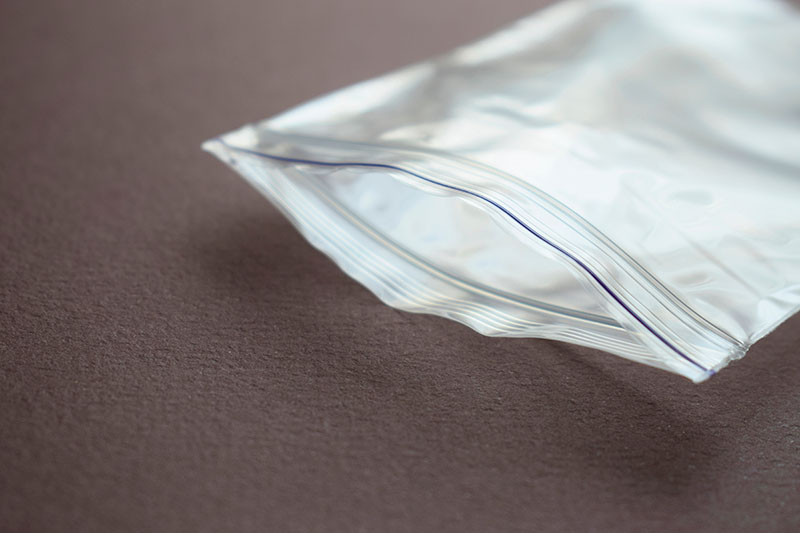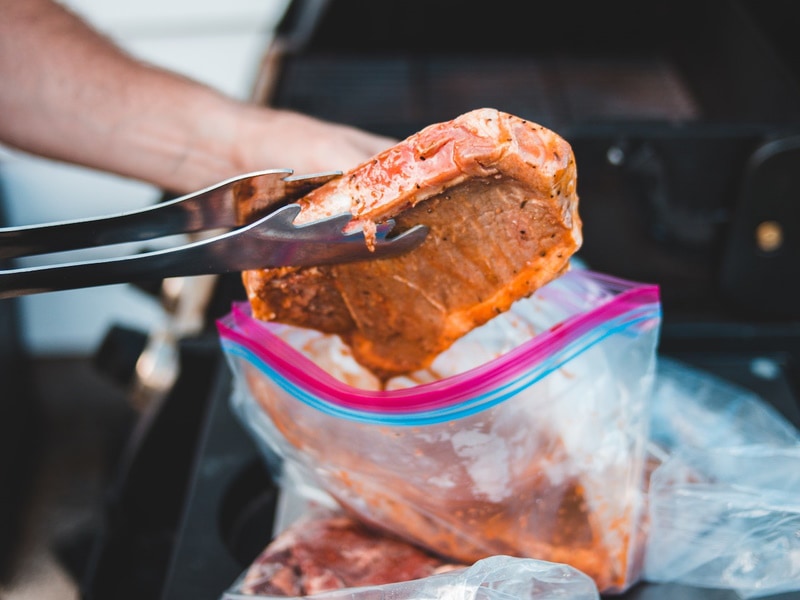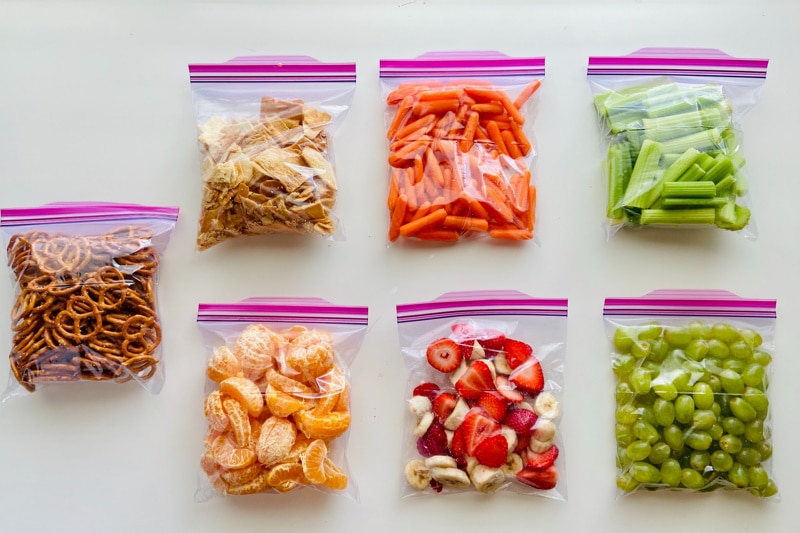Can You Microwave Ziploc Bags? (Microwave Safety Tips)
-
Pete Ortiz
- Last updated:

The Ziploc container bags and containers are very popular here in the States. Reusable and easy to re-seal, they are a go-to choice for storing stuff in the fridge or keeping your sandwiches fresh for work or school. So, can you put such a bag in the microwave? The answer is yes, but only if you want to reheat some leftovers or defrost a chicken.
In contrast, the manufacturer doesn’t recommend using Ziploc containers for steaming, boiling, or cooking. But why is that, though? You’ll find extensive answers to all your questions in our in-depth guide!
What Is a Ziploc Bag?
We often use this term to describe self-sealing containers/bags for storing food. However, Ziploc is an S. C. Johnson & Son brand of reusable storage bags that can be zipped for extended storage times. Sometimes, they have a tab instead that seals the bag. The company makes quite a few variations that differ in shape and size.
On average, families in the US use up to 500 Ziploc bags per year as containers for sandwiches and other snacks. So, what are they made of? Ziploc bags are manufactured from polyethylene plastic, LDPE, or HDPE (more commonly known as “film”). They are extra sturdy and don’t tear easily, which is one of the reasons why they’re so popular.
Are Ziploc Bags Allowed in a Microwave?

What’s the biggest appeal of a microwave? That’s right: it can quickly reheat leftovers and defrost a big chunk of meat from the fridge. These kitchen appliances work automatically and get the job done quickly. As for the Ziploc plastic bags, they are specifically designed to be microwave-friendly. On top of that, they can easily handle below-zero temperatures.
That means you can put a chicken inside a Ziploc bag, store it in the fridge, and then heat it in the microwave without ever removing the bag. So, yes, Ziploc bags are safe to put in an oven for reheating and defrosting food. However, the same doesn’t apply to cooking meals at high temps. Let’s talk about that next in more detail.
Can You Cook Food in a Ziploc Bag?
Generally, no, it’s not recommended to do any cooking, steaming, or boiling with Ziploc bags. Polyethylene deforms at 195°F (90°C). And if you expose it to slightly higher temperatures, like 212–230°F, the plastic will start to melt, which is NOT what you want. The reason: when plastic containers melt, they may leach dangerous compounds into the food.
The side effects include reduced fertility and metabolic disorders, to name a few. Now, this doesn’t mean you’ll get a lethal dose of hazardous chemicals the first time you put a Ziploc bag in your microwave oven. High-density and low-density polyethylene are among the safest plastic products. Besides, Ziploc doesn’t contain BPA. Still, to be 100% sure, you should only use it for reheating and defrosting food.
Low-Temperature Cooking With Ziploc Bags
A quick note: if you’re into sous vide cooking, you can actually use Ziploc bags for that because the temps won’t ever surpass the 190°F threshold. This French cooking technique is often used for fish, meat, and poultry dishes. Chefs set the temperature as low as 130°F for certain meals. As for the peak temps, they rarely go over 165°F.
Ziploc Alternatives: What Can You Use Instead?

So, if Ziploc bags aren’t very safe to use for boiling or steaming food in a microwave, what are your options? Well, you can always go with ceramic. This material has proven to be extremely heat-resistant, and it can easily handle 230°F and beyond. That’s because it’s made of clay and earthen elements that don’t burn—no matter how high the temperature is.
Ceramic dinnerware doesn’t break, melt, or get too hot for comfort. It will keep the food warm, but you’ll still be able to move it around. Glass and melamine work as well. But you should check their labels to make sure that they are, indeed, microwave-safe. That’s it for the dinnerware. For wrapping the food, use a thermoplastic or film that’s specifically designed to withstand cooking temperatures.
Why Are Metal, Foam, and Paper Not Recommended?
If you just want to reheat a chicken wing or a slice of pizza, you don’t have to worry about the bag. That doesn’t apply to cooking, steaming, or boiling, though. There are certain materials that shouldn’t be anywhere near a microwave. The list isn’t that big, but you should definitely know about it to avoid ruining the food, putting unnecessary stress on the oven, and turning the day into a disaster.
- Aluminum foil (might damage the microwave)
- Most plastic bags/containers (release toxins into the atmosphere)
- Brown paper bags (release toxins when heated up)
- Styrofoam (leaks chemicals into your food/beverages)
- Takeout dishes (might cause a fire in the oven)
- Disposable mugs (cause sparks when heated)
- Eggs and pepper (tend to get messy)
- Lidless containers (also get messy and potentially dangerous)
- Nothing (might cause the microwave to explode)
Are Ziploc Bags Recyclable?

The short answer is yes, you can put these bags into the same bins as the dry-cleaning, shopping, and bread/produce bags. But that also means you’ll have to go to a recycling center in your area or a retail store that will take those Ziploc bags off your hands. The good news is—you can find these drop-off spots online, no need to drive for hours before you spot one.
But plastics take a lot of time and effort to process (and up to 400 years to break down). There aren’t enough recycling facilities in the United States, Canada, or the EU to handle every single plastic container out there. Thus, some of it will end up in landfills. Going back to Ziploc bags, make sure they’re clean and dry before you drop them off.
Can I Reuse My Ziploc Containers?
Ziploc bags aren’t exactly cheap, but you don’t have to throw them away. If you take a moment to wash the bags thoroughly and let them dry for a while, they can be reused. That will not only help you save a buck or two but also keep the planet healthy. However, there are certain exceptions to this rule. Mainly, if you put fish, meat, eggs, or nuts there, don’t use that same bag for storing something else.
Otherwise, you might contaminate the food. Furthermore, you should NOT reuse Ziploc bags and put them in a microwave. We’re talking about situations when you cooked veggies yesterday and now want to use that same bag to cook a chicken or turkey—don’t do that. Ziploc bags can only be reused for reheating the same food: you eat some, store the rest for tomorrow, and then reheat it.
The Biggest Pros of Using Ziploc Bags
So, by now, we’ve learned that the world-famous Ziploc bags are microwave-compatible yet should only be used to reheat and defrost food, not to boil or steam it. They’re not very cheap, either, and take forever to decompose. Still, the advantages strongly outweigh the disadvantages, and here’s a quick look at the biggest pros of using Ziploc bags in your daily life:
- Reusable, easy to re-seal
- Sturdy and with an impressive lifespan
- An excellent choice for reheating and defrosting
- Well-suited for low-temperature cooking
- Can also be used for storing food in the fridge
- Perfect for taking a snack/sandwich to work or school
- A recyclable plastic product (at specific centers)
- Don’t contain hazardous chemicals
Conclusion
Ziploc bags have been around for many decades now and are still as widely used as ever. Simple in design yet highly effective for storing food and other stuff, these containers are life saviors around the kitchen. And they are safe to use in a microwave oven as long as you’re trying to reheat yesterday’s food or defrost some veggies, meat, or chicken.
However, you should always keep the temperature in check. Otherwise, the plastic will deform or even start to melt. So, avoid boiling/steaming in Ziploc bags, and don’t leave them in the microwave for a long time—that will save you a lot of hassle. And finally, don’t forget to recycle used bags to benefit the environment!
See also: Can You Microwave Chinese Takeout Boxes? (Microwave Safety Tips)
- Sustainability & Safety
- Plastic Pollution Is Growing
- Can You Reuse Plastic Bags?
- Prevent Cross-Contamination
- Europa.EU – Environment, Plastic Pollution
- How To Recycle Ziploc Bags?
- Drop-Off Locations
- Sous Vide Cooking
- Containers For Preparing Food
- Things You Shouldn’t Put In A Microwave
- Harvard.Edu – Is Plastic A Threat?
- Dishes For Microwave
- Washington.Edu. Ceramics
Featured Image Credit: Dzhamilia, Shutterstock
Contents


